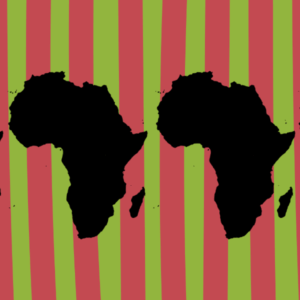
Americans Abroad: Deborah Landau and Mathangi Subramanian on Expat Writing
With Whitney Terrell and V.V. Ganeshananthan on Fiction/Non/Fiction
In this episode, poet Deborah Landau and novelist Mathangi Subramanian talk to Fiction/Non/Fiction podcast co-hosts V.V. Ganeshananthan and Whitney Terrell about their writing lives as Americans abroad. From exploring Paris’s rich expat literary history to witnessing the diversity of slums in India, Landau and Subramanian discuss what they found when they began writing in unfamiliar places.
To hear the full episode, subscribe to the Fiction/Non/Fiction podcast through iTunes, Google Play, Stitcher, Spotify, or your favorite podcast app (make sure to include the forward slashes when searching). You can also listen by streaming from the player below.
Readings for the episode:
Orchidelirium by Deborah Landau · The Last Usable Hour by Deborah Landau · The Uses of the Body by Deborah Landau · Soft Targets by Deborah Landau · A People’s History of Heaven by Mathangi Subramanian · The Day My Outrage Went Viral, Zora Magazine, Aug. 2 by Mathangi Subramanian · Picturing Change photography project (Greeshma Patel) by Mathangi Subramanian
Additional Readings:
A Moveable Feast by Ernest Hemingway · Behind the Beautiful Forevers by Katherine Boo · How To Write About Africa by Binyavanga Wainaina, Granta
Part I: Deborah Landau
Deborah Landau: I remember the first time I saw Paris, I was in college, and my roommate and I had a semester abroad at Oxford, and we went down to Paris just for a few days, and I came up from the Métro at San Michelle and it was nighttime, and the lights, and Notre-Dame, and it was just—I couldn’t believe how extraordinarily beautiful it was. And we went right to Shakespeare and Company bookshop, which is the English language bookshop in Paris, and I had no idea then that 20 years later it would become such a big part of my life.
Whitney Terrell: I was really lucky to get to go and speak to some of your students that time that I came and visited—I really loved it, and it’s right there in the center of a world that when I was young, was incredibly—I don’t know why I was so invested in the whole Moveable Feast part of Paris, like Hemingway, Stein, Fitzgerald, Josephine Baker, 1920s Paris—Hemingway had a place on Cardinal Lemoine that’s not very far from where the NYU campus is.
DL: I know. I stayed right across the street from that the first time I came to Paris, and I thought about how they used to leave their cat to watch their baby when they went downstairs to drink at the bar next door.
WT: So you were into it, too. You paid attention.
DL: Did you know that?
WT: Yes, I did know that. Why is that time so fascinating to American writers? And I don’t know if it was true for you too, Sugi.
V.V. Ganeshananthan: Yeah. I even have a part of a novel that’s set in that–
WT: –I did not know that!
VVG: Oh, no, it’s totally awful. It’s totally awful. And it will never see the light of day. But I mean, it’s very much embedded in my desire to be there. Yeah, that’s never going anywhere.
WT: I read A Moveable Feast, and then a relative gave me a book that was all the places that these famous writers hung out in Paris, and I just read it obsessively in my living room in Kansas City. How did it happen for you?
DL: Like everybody, I bought A Moveable Feast the first time I went to Paris at Shakespeare and Company bookshop, and that is apparently their bestselling book, or it was. And now, right before we leave for Paris every year, I write to the students, and I quote from that book, and the part about if you’re lucky enough to live in Paris when you’re young, then you’ll always have it with you no matter where you go, because Paris is a moveable feast. And it is. I think it is.
WT: Do you go by other places or landmarks that are important to you when you’re there? I don’t know where Gertrude Stein’s house was, or any of that kind of stuff.
DL: Yeah. We used to do a literary walking tour—we went by her house. Where else? I’ve got lots of favorite cafés. That’s a big part of being there.
WT: Let’s hear it!
DL: I like this café just up the hill—actually maybe closer to where you lived, Whitney, called Café de la Nouvelle Mairie—do you know?
We’re talking about writing overseas as a glamorous thing, and I wonder to what extent you feel like that is actually true.
WT: I don’t know it. I mean, we live in Lyon when I’m in France. So I want to know these so I can go back and visit them.
DL: Okay. I like Café Charlot in the Upper Marais a lot. I like the café at Merci, which is a big old bookstore, and they have, somehow, also clothes and housing—it’s like a Housing Works, but in France, the French version.
VVG: So we’re talking about writing overseas as a glamorous thing, and I wonder to what extent you feel like that is actually—is it glamorous to live overseas and write? I mean, I lived for a semester in Berlin, and I was at the American Academy in Berlin, much of which was glamorous in certain ways. But glamour is not what makes the words pile up on the page. How do you navigate the appeal of Paris and still keeping your own inner life and writing world?
DL: I’m there six weeks a year, and Paris is a great city for writers, it just is. There’s so much to see and smell and taste. It’s a great city for walking. It’s a great city for sitting in a café and just looking out at the world, and you can sit with your coffee, and no one ever bothers you. You can stay there all day. There’s so many small bookshops—the book is protected in France. They’re serious readers. So it’s a great city for writers. And I’m there so much now it doesn’t feel glamorous, it feels like it is work, but it’s a great kind of work. For one thing, I get an apartment without any of my kids in it. So that alone–
WT: See, now that’s glamour.
DL: –and no dogs and no husband, so that is good, just to be alone in my own space. I think all of us who go there find it really productive and worthwhile just to get out of our regular habits and routine. You’re in a completely different environment, and you see things fresh. And I think that’s always one of the reasons to travel. And that’s one of the reasons why—all the faculty, I’ve been seeing in Paris show up with their books and poems, since we started. And that’s been really fun to watch. I think we do all get a lot of work done while we’re over there.
WT: I want to mention one super glamour thing that I did get to do with Deborah and the rest of the faculty. They take a barge and do a full tour of the Seine at night, one night. And all of the students and faculty get to ride on it. It’s a bateaux mouches and it is just fantastic.
It was fruitful and enabling for his own work, to be surrounded by language, but not language that he understood.
DL: That is the one glamorous thing we do—I think it’s actually a yacht. I’m not sure—I mean, it’s a big boat.
WT: Once I was on it, I didn’t care what it was. There was champagne.
DL: We used to do it on Bastille Day until the Nice terror attack happened, and then it just started to feel a little intense on Bastille Day. So now we do it on a different night. But yeah, it is so beautiful. We serve dinner and champagne and the boat goes up and down the river, and everyone is together and away from classrooms. It’s the one highlight, high point, of the time there.
VVG: It sounds pretty great. I’m curious how your fluency in another language has changed your writing in particular, because I’m remembering when I was trying to decide, did I want to get on board the metaphorical yacht going up and down the Seine—I don’t speak French. Or at least technically, I don’t speak French, I can kind of pick up a little bit. And I was talking to another writer, actually a cousin of mine who lives in England, and he said, You work in English. What will it be like for you to be surrounded by a language that you don’t understand? And that angle hadn’t occurred to me before. And I’m just wondering how your relationship with French has affected your relationship with English over the years.
DL: Well, I always think of John Ashbery. He lived in Paris for many years, and when he started, he didn’t speak French, or didn’t speak it very well, and he talked about how fruitful it was for him or how enabling it was for his own work, to be surrounded by language, but not language that he understood. And so you could sit in public and hear voices but not get distracted or snagged away from your own thought. So I do speak French passably. I read French. It just happened it was my language in graduate school, but I didn’t know I’d be needing it. And I don’t know, I still feel when I’m there a kind of solitude in the city because it’s not my city. It’s not my language. These aren’t my people. You talked about interior life or inner life—I think it’s good for that. It’s really good for that, because you feel a bit apart from the city as you’re moving through it.
*
Part II: Mathangi Subramanian
V.V. Ganeshananthan: I was thinking, as I was reading your book about—there’s that very well known Granta piece, “How To Write About Africa,” and there are all the tropes of the “foreigner abroad,” literary tourism, as Whit said, or just voyeurism. And this book avoids that in a really interesting way. It’s a consciously feminist book, it’s interested in the politics of gender and class and labor. And your point of view choice is so interesting. You write in a very authoritative first person plural, the collective voice of the five girls, who are the book’s main protagonists. So how did you come to that?
Mathangi Subramanian: I feel like you’re the perfect person to ask me that question, because that voice is based on my memories of all of our friendships in high school. When you were so much closer to your friends than to your family, when you clung to each other for survival, which I think is a very female experience, particularly an experience among women who are dealing with things like marginalization because of race, because of gender, because of sexuality. And so that first-person plural was meant to create this feeling that I used to have as a teenager, that my friends and I were this single mass of people, and we all believed the same things, and we all wanted the same things, and we all took care of each other. And this was the same feeling I got from children living in slums. And it made me think of my own childhood. And the way that my friends and I clung to each other.
Whitney Terrell: You mentioned the word diversity a lot when we were talking about what life is like in the slums. And I’m curious about—I have not been to India. So when someone says the slums, is there a sign that says, “the slums begin here,” or are these neighborhoods that each have a name? And generally people refer to them as the slums?
MS: So there’s notified slums and there’s non-notified slums. Notified slums are recognized by the government. They often have signs and names. They often have public toilets. They often have schools built inside them. So they’re recognized by the government as slum lands. Non-notified slums are slums that just pop up, that the government has decided not to notify, specifically because they’re in areas that have the potential for commercial development, and therefore can be destroyed because there’s basically no paperwork. Now, it is more complicated than that.
But that’s a general overview. Because nowadays, as you know, India is rapidly urbanizing, being notified doesn’t protect you in the way that it used to. But you know a slum when you see it. Some of them have been there for 30 or 40 years, and so there are some brick houses, but for the most part, they’re tents. Even in Tamil, we use this word in India: pakka houses. It’s a Hindi word. It means a real house versus a non-real house. So you won’t see any pakka houses—you’ll see asbestos siding. I guess it’s one of those things where if you grow up in a developing country, or around developing countries, you recognize when you see it.
WT: So when you mention diversity in those spaces, you’re not just talking about income diversity, right?
MS: There’s no income diversity.
WT: Okay, so what was the diversity that surprised you there? It’s that there’s also queer people and trans people in those spaces—am I correct in thinking that?
MS: Yeah, there’s queer people. There’s trans people, there’s Muslim people, there’s Dalit people—in Bangalore, especially, because it’s a center of jobs around the South, you also get people from all over India, and increasingly from other countries. So we had Bangladeshis in one of the anganwadis. We had Nepalis in one of the anganwadis. And the teachers were just so adept at learning enough words in every language that they could speak to every child in their own language.
And there was also just a diversity of personalities. I think there’s a conversation happening now in the US about how there are lots of ways to be a black person, there are lots of ways to be a brown person, but I think when people think of poverty, and they think of the developing world, they don’t necessarily remember that there are also lots of ways to be a poor person . . . Just because you’re at a low income level doesn’t mean that you’re automatically straight, or you’re automatically cis. I was a little bit ashamed that this surprised me, but it definitely took me by surprise, because when you see things like Slumdog Millionaire or White Tiger, you have a certain archetype of a poor person. It’s usually male, it’s usually straight. And, in reality, a slum is just like any other microcosm of humanity. There’s so many different kinds of people who live there.
The difference between the images people from the slums picked, and the images that people outside the slums picked, was quite striking.
VVG: Yeah. I was reminded intensely as I was reading your book of Behind the Beautiful Forevers by Katherine Boo, which is a nonfiction book, which is structured in many ways very much like a novel. And it also pays, unusually I think, specifically for nonfiction, it pays an incredible amount of attention to the feelings of women and children, and the complexity of non-binary identities and class and caste. And I remember reading that book and being like, “Oh, my God, how much do women and children get asked about their feelings? Why don’t more people ask them about their feelings?”
The agency that that structure gave them, and the agency that your structure gave them, while also respecting community identity and community accountability, I thought was really interesting. And you mentioned the character of Deepa inspired in part by the girl that you knew with visual impairment. And you also, earlier, mentioned the white photographer, and you wrote from the point of view of the five girls and we see this character who is a “foreign woman.” What was inverting that power dynamic like for you? How did you think about writing that character and her role in the plot? And was she always in the book, because I felt like she was almost a guest—I mean, she, of course, belongs in your novel—but I mean, like a guest from another kind of narrative, and that we got to see her from a different angle, which was really cool.
MS: It took me a while to find her, which is maybe why it does feel like she came later, because she definitely did in the process of coming up with the structure. So the photographer is actually inspired by the fact that often white photographers do come to India, and they seem very—I don’t know what the word is—maybe fascinated with slum demolitions. And I think, particularly because one of the first things I did in India was help facilitate this photography project, the difference between the images people from the slums picked, and the images that people outside the slums picked, was quite striking.
To be honest, the character was very much inspired by my own experiences and my own discomfort of being in these spaces, and trying to be the helpful foreign woman. Whit, you asked me about reciprocity. And I mean, I was that bumbling woman who didn’t know what I was doing, but luckily everybody around me knew what they were doing. And they were like, “Well, here’s an American lady, let’s see what we can get out of her.”
WT: I mean, that’s the fictional version. And I think this is a useful craft thing. I know we have a lot of writers and emerging writers who listen to the show—I heard this phrase. I don’t watch NASCAR, and I can’t believe I’m going to use a NASCAR metaphor–
In the slums, the women are the ones running the place, and doing all the activism yet they’re invisible in stories about poverty.
VVG: Oh my God! What’s happening?
WT: This is true. This is a true thing, that what you’re advised to do if you’re a NASCAR driver, apparently, is steer into the wreck. So if there’s a wreck—no, I heard this on Talladega Nights! That’s what it’s from! Terrible movie.
VVG: Oh my God, you’re quoting Talladega Nights as a craft thing–
MS: That is a serious source.
WT: Steer into the wreck!
MS: This a serious podcast, folks.
WT: I find if there’s something that I am nervous about, in my fiction, as you were saying, like, I’m nervous about my position, vis-a-vis, the people I’m writing about, like, what I have to do is rather than avoid it, or try to bury it, I have to go right at it, and try to deal with it directly. And it sounds like this character was a way for you to deal with some of those feelings.
MS: Completely. Some of the scenes of motherhood where the mothers don’t really know what they’re doing, those were also definitely coming from my experience of being a new mother, and trying to write mother characters. The other thing that was really fun to write about this character, besides the catharsis of exposing my own hypocrisy and my own insecurities, was that the photographer, like me, doesn’t speak very many Indian languages, and the ones that she does speak she doesn’t speak well. So she only speaks Hindi, and she speaks it terribly. So I wrote her entire scenes in broken English. And it was so cathartic to have a white person speak in broken English, while all the brown people around her were speaking in this beautiful poetry. And it felt like such a subversive—Sugi’s laughing because you know exactly what I mean, right?
VVG: [Laughing] Yes!
MS: When you pick up these books and all of the diaspora characters are speaking in weird broken English, when that’s not how my parents speak. There are people who speak like that, but not all of us speak like that. So to be able to write the white character as the person who was bumbling and couldn’t form a sentence felt really fun, and also really necessary in this context, because the fact is—and Sugi, I think you alluded to this a little bit earlier—in slums, the women are the ones running the place because the men are gone all day, or, you know, there are a lot of drunk men in slums, there’s a lot of men who don’t have their act together. And the women are also the ones doing all of the activism. They’re the ones who are in front of the bulldozers, they’re the ones who are going to the courthouses and asking for a stay, they’re the ones who are going to the wealthy owners of the homes where they work and asking for help. They are the ones who are in charge, but so often they are completely invisible in stories about poverty in the developing world. So to have this photographer show up and just be manipulated by—not just the women, but by the girls–
VVG:–it’s super satisfying. It’s super effing satisfying to read.
MS:–it was therapy.
WT: I have one editorial note: while you were talking, I realized that that line about steering into the wreck is not from Talladega Nights. I heard it on The Bill Simmons Podcast.
VVG: It’s too late, Whitney. We all know you’ve seen Talladega Nights now. You can’t hide it.
MS: This is highly disappointing. Highly disappointing.
Transcribed by https://otter.ai and condensed and edited by Damian Johannson, Chloe Seim, and V.V. Ganeshananthan.
Fiction Non Fiction
Hosted by Whitney Terrell and V.V. Ganeshananthan, Fiction/Non/Fiction interprets current events through the lens of literature, and features conversations with writers of all stripes, from novelists and poets to journalists and essayists.



















